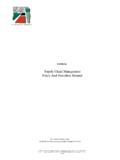Transcription of CONSTITUTIONAL COURT OF SOUTH AFRICA Case …
1 CONSTITUTIONAL COURT OF SOUTH AFRICACase (1) CCT 21/98 BONGANI DLAMINIA ppellantversusTHE STATE Respondentand Case (2) CCT 22/98 VUSI DLADLA First ApplicantANGEL KHUMALOS econd ApplicantWILLY SINDANE Third ApplicantJOHN SIBONYONI Fourth ApplicantPHILLIP MOGABUDI Fifth ApplicantversusTHE STATE Respondent and Case (3) CCT 2/99 THE STATE AppellantversusMARK DAVID JOUBERT Respondentand Case (4) CCT 4/99 THE STATEA ppellantversus 2 JAN JOHANNES SCHIETEKAT RespondentHeard on:(1)18 February 1999 (2)-(4)10 March 1999 Delivered on: 3 June 1999 JUDGMENTKRIEGLER J: Introduction[1]Each of the four cases considered in this judgment is concerned with theconstitutional validity of one or more provisions of the SOUTH African law relating to provisions relate to the admissibility of the record of bail proceedings at trial, thetest in the grant of bail particularly where serious offences are concerned, and access tothe police docket for purposes of a bail application.
2 Some provisions are challenged inmore than one of the cases; several of the challenges rely on more than one constitutionalground and many of the provisions being challenged are interrelated. It is thereforesensible to examine the various CONSTITUTIONAL challenges together rather than on a case-by-case approach. [2]Although the transition to the new dispensation kept the general body of SouthKRIEGLER J1As explained in In re: Certification of the constitution of the Republic of SOUTH AFRICA 1996, 1996 (4)SA 744 (CC); 1996 (10) BCLR 1253 (CC) para 13, the country adopted a two-stage approach to itstransition to a CONSTITUTIONAL democracy. Both the ( interim ) constitution of the Republic of SOUTH AfricaAct 200 of 1993 ( the interim constitution ) and the constitution of the Republic of SOUTH AFRICA , 1996( the constitution ) expressly kept in place all legislation existing at their respective dates of is provided by s 229 of the former and s 241 read with item 2 of sch 6 (comprising 28 sections and4 annexures, each containing a number of sections) of the 15 of the interim constitution , in ss 229 to 247, and sch 6 to the constitution make detailedprovision for the continuation of the business of state during the transition.
3 The complexity of thatexercise and the difficulties it entailed are outlined in Executive Council, Western Cape Legislature andOthers v President of the Republic of SOUTH AFRICA and Others 1995 (4) SA 877 (CC); 1995 (10) BCLR1289 (CC) at para 7. 3 Now contained in chapter 2 of the constitution and previously in chapter 3 of the interim constitution (effective from 27 April 1994 to 3 February 1997). Section 39(2) of the constitution provides as follows: When interpreting any legislation, and when developing the common law or customary law,every COURT , tribunal or forum must promote the spirit, purport and objects of the Bill of Rights. 4In terms of ss 7(2) and 35(3) of the interim constitution (echoed and reinforced in ss 8(1) and 39(2) ofthe constitution ) the Bill of Rights had an immediate and pervasive impact. They provide as follows:7(2): This Chapter shall apply to all law in force and all administrative decisions taken and actsperformed during the period of operation of this constitution .
4 35(3): In the interpretation of any law and the application and development of the common lawand customary law, a COURT shall have due regard to the spirit purport and objects of thisChapter. 3 African law1 and the machinery of state2 intact, the advent of the Bill of Rights3 exposedall existing legal provisions, whether statutory or derived from the common law, toreappraisal in the light of the new CONSTITUTIONAL norms heralded by that Theretention of the existing legal and administrative structures facilitated a reasonablysmooth transition from the old order to the new. But the transition did have an effect onthe country s criminal justice system. People who had acquired specialised knowledgeof the system, and had become skilled and sure-footed in its practice, were confrontedwith a new environment and lost their confidence. Particularly in the lower courts, wherethe bulk of the country s criminal cases is decided, judicial officers, prosecutors,practitioners and investigating officers were uncertain about the effect of superimposingKRIEGLER J5Mr d Oliviera SC, who has often represented the state in cases before this COURT and is the DeputyNational Director of Public Prosecutions and a former attorney-general, speaks with the voice of authorityand experience.
5 He argued the prosecution s case in the current matter of Dladla and Others and in doingso graphically described how profoundly the Bill of Rights has affected the day-to-day administration ofcriminal justice and pleaded for understanding for the plight of law enforcement agencies. He and otherrepresentatives of the prosecution services have in the past made similar has been ongoing debate among politicians, the police and the general public about the criminaljustice system. Some judges and a number of spokespersons of provincial attorneys-general, police liaisonoffices and unions as well as influential national non-governmental organisations publicly expressedconcern about perceived laxness in the granting of bail. Indeed, a rise in the rate of crime in general andof violent crime in particular became the subject of ongoing public debate and political contention bothin and outside Parliament. Regrettably the product was often heat rather than there was a steady stream of new and stimulating insights from legal academics, their viewswere inherently prospective, sometimes speculative and seldom harmonious.
6 At the same time, judicialpronouncements by the high courts on the interaction between constitutionality and criminal justice wererelatively few and uncoordinated, arising as they do on a case-by-case basis. For historical andjurisdictional reasons, judgments of the high courts were seldom constitutionally based. Under bothconstitutions cases are resolved on CONSTITUTIONAL grounds only where it is necessary to do so and, underthe interim constitution , provincial and local divisions of the Supreme COURT had limited constitutionaljurisdiction while the Appellate Division had none at , early in 1988 and long before the interim constitution introduced its particular uncertainties,there were sufficient questions concerning bail law for the SOUTH African Law Commission to start aninvestigation of the topic. See SOUTH African Law Commission Report, Project 66: Bail Reform in SouthAfrica, December 1994, par Kurt X Metzmeier in an article: Preventive Detention: A Comparison of Bail Refusal Practices inthe United States, England, Canada and other Common Law Countries , 8 Pace International LawReview, 399.
7 Seventh century Anglo-Saxon laws provided for a form a blood money, called borh (cfthe Afrikaans word for both bail and suretyship, viz borg ), which was deposited pending trial. By the9th or 10th century, says Metzmeier, relying on Stephen A History of the Criminal Law of England (1883),a practice seems to have evolved for an arrestee or his family to pay or promise money to the sheriff assecurity for the arrestee s release pending trial. See also J van der Berg: Bail: A Practitioner s Guide,(1986) (Juta & Co) paras 1-2. Bail s SOUTH African roots can be traced back to (Cape) Ordinance 40 (1828) which laid the foundationof, among others, criminal procedure in this country and first made clear provision for the release of an4the norms of a rights culture on a system that had evolved under a wholly differentregime; and about the effect of that superimposition in a given Bail was noexception. On the contrary, much of the public debate,6 and much of the concern inofficial circles about law enforcement has been directed at the granting or refusal of [3]The origins of bail are obscured in the mists of Anglo-Saxon history 8 and itsKRIEGLER Jawaiting trial prisoner on bail.
8 (See generally: Dugard, The History of SOUTH African Criminal Procedure,in Vol IV of SOUTH African Criminal Law and Procedure, (1977) (Juta & Co), pp 18-25, and theauthorities there cited.) Subsequently the Cape Ordinance served as a model for similar statutes in Nataland the two Boer Republics. Shortly after the SOUTH African War a comprehensive criminal procedurecode (Ordinance 1 of 1903) was introduced in the Transvaal Colony, which was to form the basis of thefirst national criminal code, Act 31 of 1917, and its successor, Act 56 of 1955. 9In Bail: An Ancient Practice Reexamined , Vol 70 The Yale Law Journal [1961] 966, (anon).10 Terblanche, Borgtog: `n labarintiese doolhof? 1988 (2) SOUTH African Journal of Criminal Justice the epithet is apt, can be judged from a survey of the Butterworths Consolidated Index andNoter-Up (1947-1995), which contains many dozens of reported judgments on bail dealing with a varietyof principles and innumerable instances of their application.
9 11 Act 51 of S v Hlongwane 1989 (4) SA 79 (T) the COURT thoroughly examined the question, identifying a numberof dissonant decisions, and at 95D to 97E identified ten basic propositions, one of which (no 3) was thatfrom lawful arrest to sentence chapter 9 alone governs. See also Beehari v Attorney-General, Natal 1956(2) SA 598 (N); Ex parte Graham: In re United States of America v Graham 1987 (1) SA 368 (T). Lansdown and Campbell: SOUTH African Criminal Law and Procedure, Vol V, (Juta & Co) (1982) at 311opine that .. bail is now the only remaining machinery for the protection of the liberty of the subjectagainst unnecessary or avoidable pre-trial detention .. and proceed to cite Beehari s case as authorityfor the proposition that the .. complete and exhaustive statement regarding bail is now set out inChapter 9 .. 5modern dimensions remain an incoherent amalgam of old and new ideas serving moreto defeat than to achieve the aims of the criminal process.
10 9 In SOUTH AFRICA , judicialpronouncements on the topic have been called labyrinthine .10 There is murkiness evenat the elemental level of the source(s) of SOUTH African judicial power to grant bail, the power derives exclusively from - and is circumscribed by - chapter 9 of theCriminal Procedure Act11 (the CPA) or whether there is a parallel reservoir of inherent or common law power on which a judge can [4]An important aim of this judgment is to show that the application of constitutionalnorms to the law and practice of bail does not complicate the task of judicial officers butclarifies it. At the same time it will be shown how recent amendments to the relevantKRIEGLER J13 The corresponding provision of the interim constitution is s 25(2)(d), which reads: Every person arrested for the alleged commission of an offence shall, in addition to the rightswhich he or she has as a detained person, have the right .. (d) to be released from detentionwith or without bail, unless the interests of justice require otherwise.
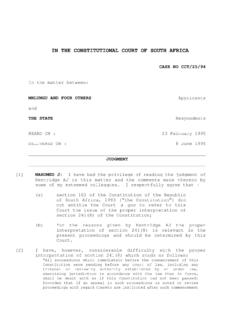
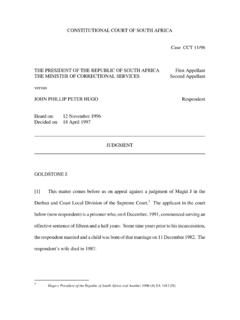
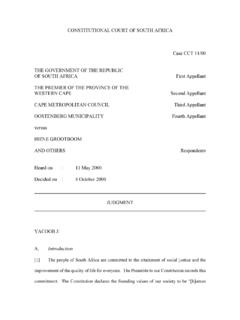
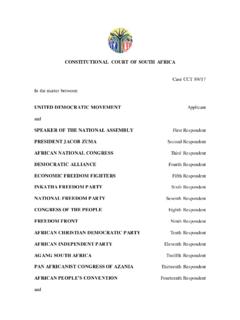
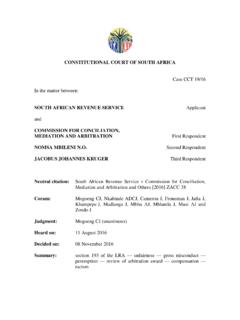
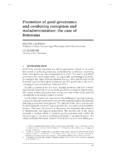
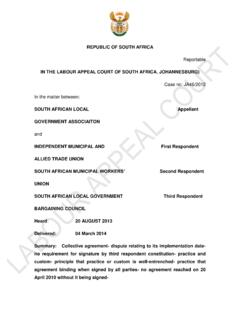
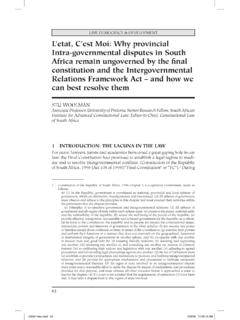
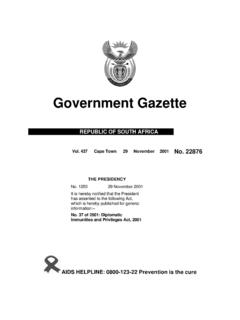
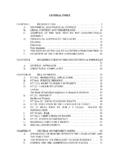
![[4830-01-p] DEPARTMENT OF THE TREASURY …](/cache/preview/6/5/b/9/7/a/d/5/thumb-65b97ad51eb0fa6035789892393b945e.jpg)


